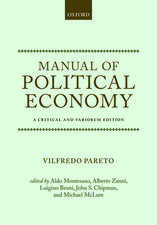Phases of Economic Growth, 1850–1973: Kondratieff Waves and Kuznets Swings
Autor Solomos Solomouen Limba Engleză Paperback – 28 feb 1990
Preț: 282.10 lei
Nou
Puncte Express: 423
Preț estimativ în valută:
53.98€ • 56.51$ • 44.66£
53.98€ • 56.51$ • 44.66£
Carte tipărită la comandă
Livrare economică 05-19 aprilie
Preluare comenzi: 021 569.72.76
Specificații
ISBN-13: 9780521389044
ISBN-10: 0521389046
Pagini: 216
Dimensiuni: 152 x 228 x 12 mm
Greutate: 0.32 kg
Ediția:Revised
Editura: Cambridge University Press
Colecția Cambridge University Press
Locul publicării:Cambridge, United Kingdom
ISBN-10: 0521389046
Pagini: 216
Dimensiuni: 152 x 228 x 12 mm
Greutate: 0.32 kg
Ediția:Revised
Editura: Cambridge University Press
Colecția Cambridge University Press
Locul publicării:Cambridge, United Kingdom
Cuprins
List of figures; List of tables; Preface; Acknowledgements; 1. Perspectives on long-term economic growth variations; 2. Statistical methodology; 3. Production trends in the world economy; 4. Price trends; 5. Innovation clusters and Kondratieff waves; 6. The national aspects of Kuznets swings, 1850–1913; 7. The international aspects of Kuznets swings, 1850–1913; 8. A long-term perspective of interwar economic growth; 9. Some conclusions on the postwar boom, 1950–1973; 10. Conclusions; Notes; Bibliography; Index.
Recenzii
'This book is of great importance. For the whole of the period for which adequate statistics are available, it confronts the main theories of fluctuations in economic growth with the evidence. The result is fascinating, and at times devastating. Solomou's achievement in this terse and clear book of 170-odd pages is remarkable. His handling of the main statistical series on growth is masterly; as to the multitude of possible explanatory factors his knowledge of the secondary sources is clearly encyclopaedic, and he gives their gist in a richly informative way without losing sight of his general argument. Anyone interested in the recent economic history of the major Western economies, or the world economy, should read and re-read Solomou; so should economists interested in growth.' The Economic Journal
'Overall, Solomou's arguments are plausible and his reasoning cogent. He has amassed a great amount of information to support his conclusions. His prose style is clear and crisp.' The Times Higher Education Supplement
'The author has written an important book, one in which various theories of fluctuations in economic growth are challenged with the evidence and are submitted to searching analytical and statistical scrutiny of a higher order … The arguments and findings of this stimulating book are important both for economists and economic historians, and should lead to much fruitful and detailed research. The author is to be congratulated.' The Economic History Review
'Overall, Solomou's arguments are plausible and his reasoning cogent. He has amassed a great amount of information to support his conclusions. His prose style is clear and crisp.' The Times Higher Education Supplement
'The author has written an important book, one in which various theories of fluctuations in economic growth are challenged with the evidence and are submitted to searching analytical and statistical scrutiny of a higher order … The arguments and findings of this stimulating book are important both for economists and economic historians, and should lead to much fruitful and detailed research. The author is to be congratulated.' The Economic History Review















